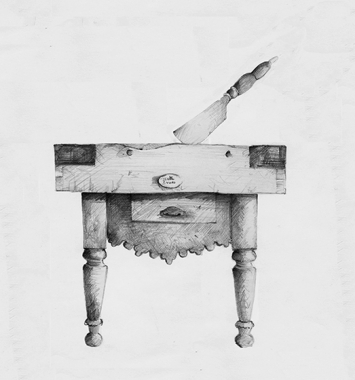La Table de Boucher
La Table de Boucher
Butchery is a mysterious art somehow - it is one of life’s processes that elicits truly conflicted emotions. I can think of no other trade that dances so precariously on the edge of horror and beauty.
It is in France that one so often encounters a traditional butcher’s shop operating now as it always has, defiantly resisting the march of time and modernisation. The shop frontage is intricately tiled like the scales of some exotic beast and the word Boucherie crawls across the window in scratched, italic, gold script. The ominous gleam of metal blades and implements is discernible in the shadowy interior against an elegant backdrop of timeworn marble. Meat is displayed neatly ordered in the window and pretty lines of ruffled parsley separate one section from the next. Price tickets impale various cuts of meat and they are decorated with the butchery’s logo - an unnervingly cheerful pig portrayed in a chirpy 1930’s graphic style. You enter the shop, it smells like history and you immediately covet the polished brass scales on the counter and are determined to find a replica of the butcher’s smart indigo blue apron before you leave France. The scene is infused with the romance of a utilitarian yet noble profession and you are
captivated.
The image of such a butchery nestles somewhere in our mind alongside reveries of culinary excellence. The heady scent of a slow cooked and sweetly spiced beef daube, the delicate sizzle of the perfect steak, cooked `a point with a hint of anchovy butter added as it rests, salty and succulent lamb served with a gratin dauphinois - the undeniable pleasure of dining well. A delicious meal enjoyed in appropriate surroundings with the right company is one of the great pleasures of civilised culture - yet once in a while, if we allow ourselves to think about it, we are visited by a feeling of unease as we remember that on our plate is a piece of dead animal, an animal that not so long ago was enjoying the sunshine and leisurely chewing grass, innocent and unaware of it’s impending fate. In those moments we realise with deep certainty that there is not much that is civilised about being civilised.
I suffer immensely from these conflicted emotions - if I allow my mind to roam into these spaces I find that I can barely touch the meat that was intended for that night’s dinner yet I find it hard to resist ordering the steak frites on the bistro menu. I imagine I am not alone. I have no answers and obviously no conviction,
just a vague sense that this most disturbing arrangement is yet another of life’s odious imperfections - an everyday atrocity that I wish were not so.
The carnivorous activities of our predecessors have however given rise to some attractive furnishings and accoutrements associated with butchery - French butcher’s blocks are not only beautiful to look at but a most useful addition to any kitchen - whether it is a leg of lamb you are deboning or simply chopping the vegetables for a vegetarian cassoulet.
If you are currently redecorating or designing a new kitchen we have two lovely butcher’s blocks in stock at Haunt as well as many culinary connected pieces of furniture and accessories.

